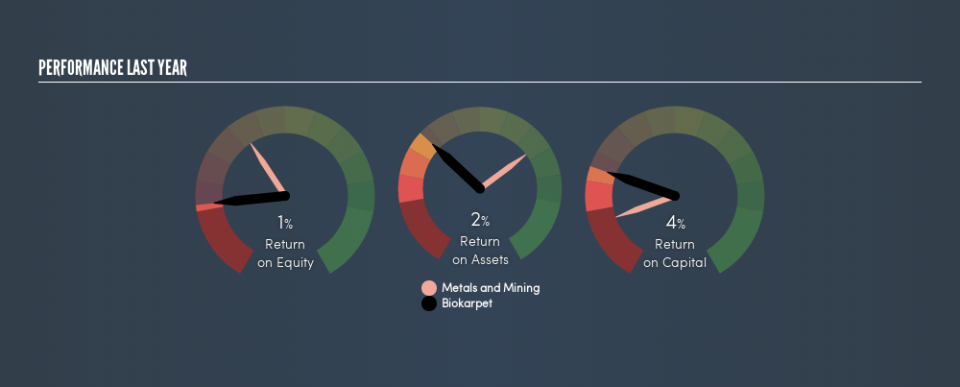Shareholders Should Look Hard At Biokarpet S.A.’s (ATH:BIOKA) 3.5% Return On Capital

Want to participate in a short research study? Help shape the future of investing tools and you could win a $250 gift card!
Today we'll evaluate Biokarpet S.A. (ATH:BIOKA) to determine whether it could have potential as an investment idea. In particular, we'll consider its Return On Capital Employed (ROCE), as that can give us insight into how profitably the company is able to employ capital in its business.
First of all, we'll work out how to calculate ROCE. Next, we'll compare it to others in its industry. Finally, we'll look at how its current liabilities affect its ROCE.
What is Return On Capital Employed (ROCE)?
ROCE is a measure of a company's yearly pre-tax profit (its return), relative to the capital employed in the business. In general, businesses with a higher ROCE are usually better quality. Ultimately, it is a useful but imperfect metric. Renowned investment researcher Michael Mauboussin has suggested that a high ROCE can indicate that 'one dollar invested in the company generates value of more than one dollar'.
So, How Do We Calculate ROCE?
The formula for calculating the return on capital employed is:
Return on Capital Employed = Earnings Before Interest and Tax (EBIT) ÷ (Total Assets - Current Liabilities)
Or for Biokarpet:
0.035 = €3.2m ÷ (€124m - €34m) (Based on the trailing twelve months to December 2018.)
Therefore, Biokarpet has an ROCE of 3.5%.
See our latest analysis for Biokarpet
Is Biokarpet's ROCE Good?
One way to assess ROCE is to compare similar companies. In this analysis, Biokarpet's ROCE appears meaningfully below the 10% average reported by the Metals and Mining industry. This performance could be negative if sustained, as it suggests the business may underperform its industry. Independently of how Biokarpet compares to its industry, its ROCE in absolute terms is low; especially compared to the ~4.9% available in government bonds. Readers may wish to look for more rewarding investments.
Biokarpet has an ROCE of 3.5%, but it didn't have an ROCE 3 years ago, since it was unprofitable. This makes us wonder if the company is improving. You can see in the image below how Biokarpet's ROCE compares to its industry. Click to see more on past growth.
When considering this metric, keep in mind that it is backwards looking, and not necessarily predictive. ROCE can be misleading for companies in cyclical industries, with returns looking impressive during the boom times, but very weak during the busts. ROCE is only a point-in-time measure. We note Biokarpet could be considered a cyclical business. If Biokarpet is cyclical, it could make sense to check out this free graph of past earnings, revenue and cash flow.
Do Biokarpet's Current Liabilities Skew Its ROCE?
Liabilities, such as supplier bills and bank overdrafts, are referred to as current liabilities if they need to be paid within 12 months. The ROCE equation subtracts current liabilities from capital employed, so a company with a lot of current liabilities appears to have less capital employed, and a higher ROCE than otherwise. To counteract this, we check if a company has high current liabilities, relative to its total assets.
Biokarpet has total liabilities of €34m and total assets of €124m. Therefore its current liabilities are equivalent to approximately 28% of its total assets. With a very reasonable level of current liabilities, so the impact on ROCE is fairly minimal.
Our Take On Biokarpet's ROCE
Biokarpet has a poor ROCE, and there may be better investment prospects out there. You might be able to find a better investment than Biokarpet. If you want a selection of possible winners, check out this free list of interesting companies that trade on a P/E below 20 (but have proven they can grow earnings).
I will like Biokarpet better if I see some big insider buys. While we wait, check out this free list of growing companies with considerable, recent, insider buying.
We aim to bring you long-term focused research analysis driven by fundamental data. Note that our analysis may not factor in the latest price-sensitive company announcements or qualitative material.
If you spot an error that warrants correction, please contact the editor at editorial-team@simplywallst.com. This article by Simply Wall St is general in nature. It does not constitute a recommendation to buy or sell any stock, and does not take account of your objectives, or your financial situation. Simply Wall St has no position in the stocks mentioned. Thank you for reading.

